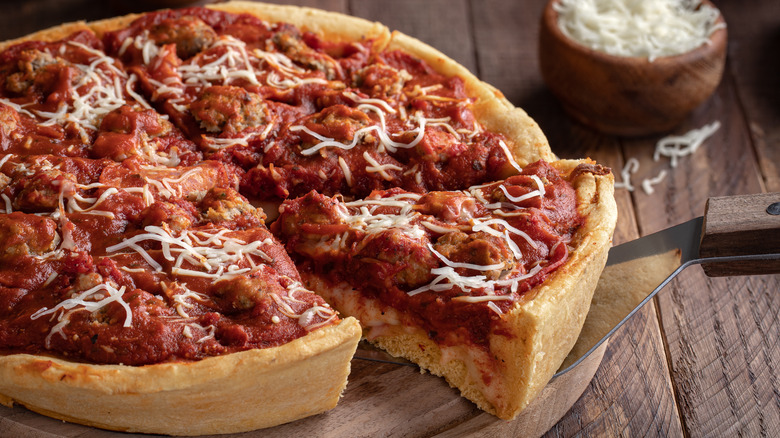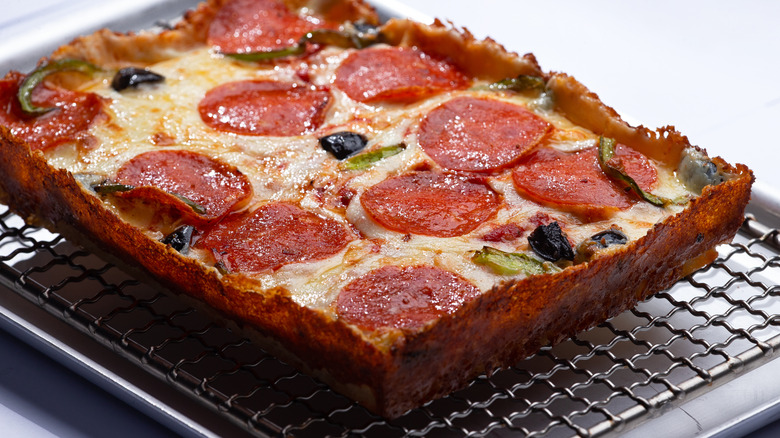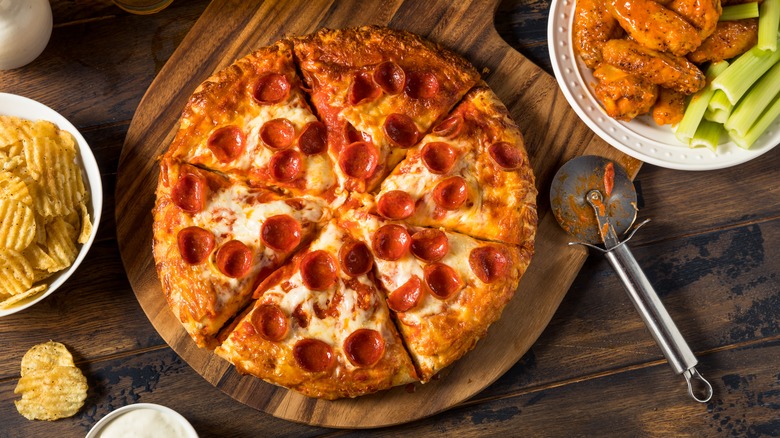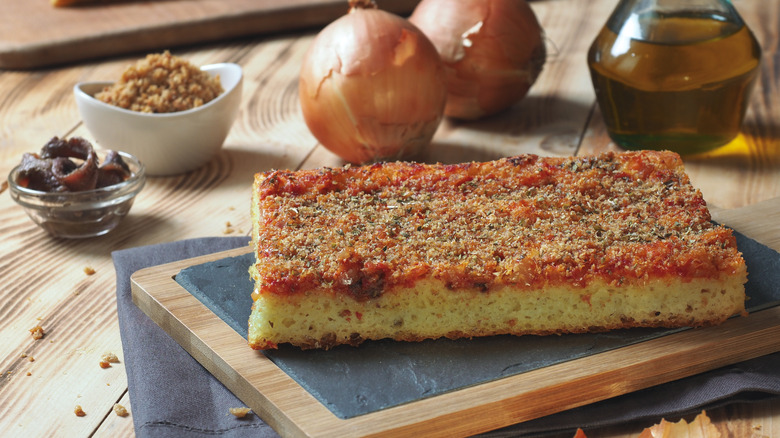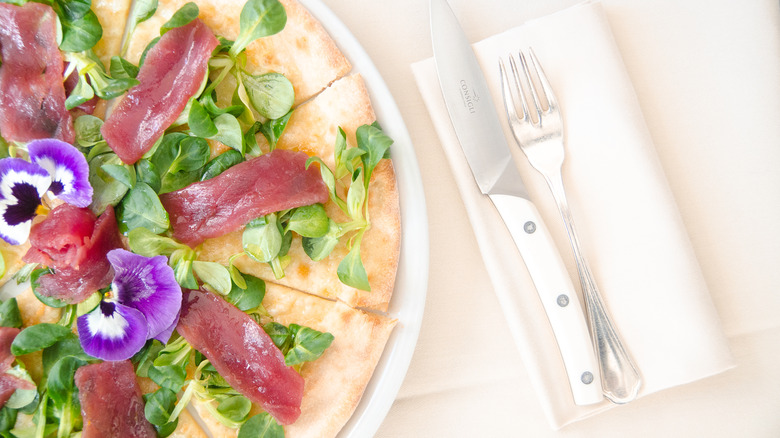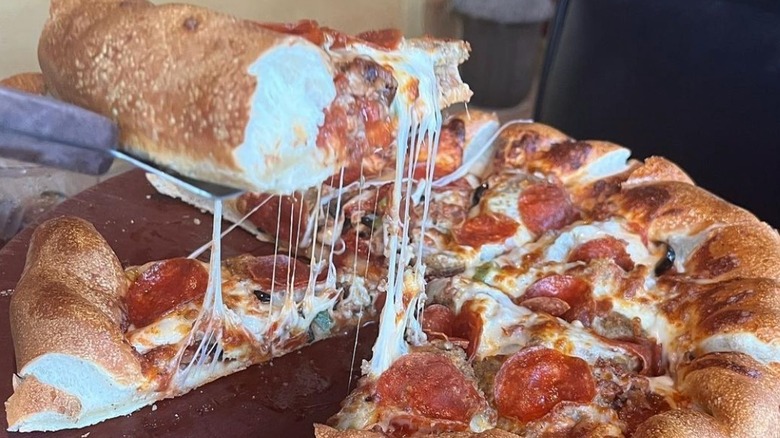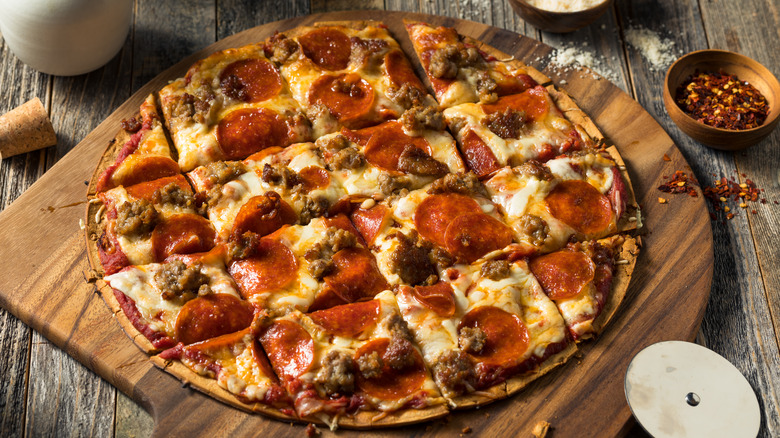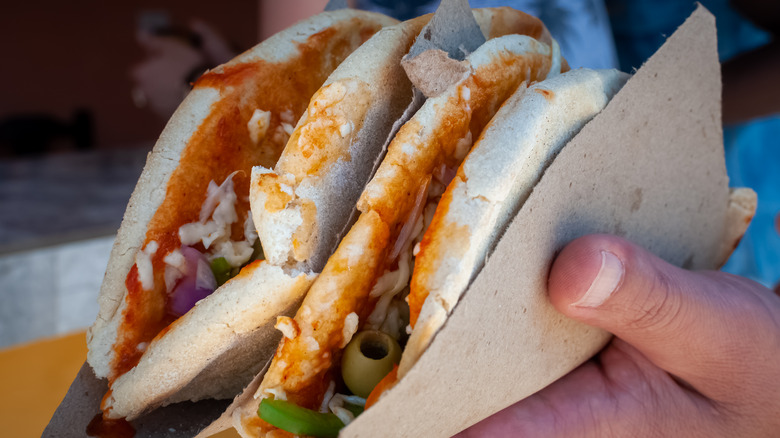12 Pizza Styles From Across The US, Explained
America's regional pizza styles span the entire alphabet, from "apizza" to "pizzaz". While most are universally beloved, some have unleashed a firestorm of controversy fit for any comment section.
Naturally, we have to give a hat-tip to Italy for creating pizza, and American styles can be traced back to the old country through one of two branches: Neapolitan- or Sicilian-style pizza. Immigrants from Naples brought over a preference for floppy, thin-crust pizzas that bake quickly. Sicilian immigrants brought over a preference for thick-crust pizza that resembles Italian focaccia and calls for a longer bake time.
Once these two Italian styles reached America's melting pot, they took on lives of their own. Some U.S. styles are defined by their toppings. St. Louis pizza wouldn't be St. Louis pizza without Provel cheese. Others, like Detroit- and Chicago-style pizzas, are defined by how they're baked.
The great thing about American pizza is that it's always evolving, which is reflected in the following list. If you're a purist who insists on things remaining the same in perpetuity, you've been warned.
New York
As a general rule of thumb, American pizza tends to get more Americanized over time and distance. The earliest Italian immigrants came to New York City in massive waves, and because of that, New York-style pizza bears a strong resemblance to traditional pies made in Italy, and Naples specifically.
In the late 18th and early 19th centuries, some Italian immigrants in New York opened bakeries with coal-fired ovens that served pizza alongside other baked goods. The evolution of Neapolitan-style into New York-style pizza happened after World War II when gas replace coal as a heat source. Being more convenient and controllable, gas ovens allowed pizzerias to focus on volume and speed. The resulting pizzas were just as thin, but larger and less charred. Over time, large, floppy slices of pizza became synonymous with walking around New York City. Their size and ability to be held with one hand made New York-style slices perfect for on-the-go residents of the Big Apple.
Chicago deep dish
If New York-style pizza is meant to be eaten on the go, Chicago-style is supposed to be eaten as an indoor, sit-down meal, while the winds off Lake Michigan whip up outside. Chicago-style pizza, like the Midwest, is also homier and more comforting. If you're looking for a slice of pizza so rich you need to take a nap afterward, you're riding with deep dish pizza.
Like New York style, Chicago-style deep dish pizza came about in the middle of the 20th century. In the 1940s, Pizzeria Uno was looking to provide an alternative to popular Neapolitan-style pizzas when someone at the restaurant developed a pie with a thick crust that was basked in a circular pan, like the type you would use to bake a cake.
This style of pizza became so popular that it inspired a number of copycats. Today, there are many places where you can get a unique spin on this Chicago classic. Oprah Winfrey favorite Bacino's is widely recognized as having one of the best deep-dish pizzas in Chicago. Lout Malnati's has won over fans with its vine-ripened California tomatoes and artisanal mozzarella cheese. One course you can still try the original model at Pizzeria Uno's. With dozens of locations worldwide, there's probably one pretty close to where you're reading this.
Detroit
For decades, Little Caesars was known around the country for its cheap, cheap pizza. Somewhere along the way, the restaurant's unique rectangular pizza pie became known as Detroit-style — putting a bit more respect on the restaurant's name. Before Little Caesars was spreading the gospel of Detroit-style pizza far and wide, residents of the Motor City had been enjoying rectangular pizzas baked in a deep pan ever since debuting at Buddy's Pizza in 1946. Inspired by thick Sicilian-style dough, chef-owner August "Gus" Guerra famously repurposed a steel automotive pan to develop his groundbreaking pie. A signature feature of Detroit style-pizza is how the Wisconsin mozzarella cheese melts over the edge of the crust, creating a salty, caramelized crust on the perimeter. This pizza style is also known for putting the sauce on top of the cheese, but it doesn't always come that way.
If you can't get to Buddy's or Detroit or Little Caesar's for that matter, you could follow our essential Detroit-style deep dish pizza recipe. It calls for a dough made with bread flour and a combination of sliced provolone and sliced mozzarella. Just make sure you spread cheese all the way to the edge and bake everything in a rectangular pan.
Buffalo
If you're going to Buffalo, New York to take in the majesty of Niagara Falls, marvel at Glided Age architecture, or, say, get body slammed through a folding table from the top of a bus before a Bills game, then you're probably laser-focused on trying the city's iconic chicken wings. But while doing all that, don't sleep on Buffalo's signature style of pizza pie.
Located at the western end of New York State, Buffalo is caught between cultural associations with New York City and the Midwest. The city's signature pizza style is a manifestation of the city's middle-ground nature. Buffalo-style pizza has an extra-medium crust that splits the difference between the deep-dish style of Detroit or Chicago and the thin-crust style of the Big Apple. Buffalo-style pizza is also unique for its quarter-sized pepperoni that cups and chars when cooked. Add in a heavy blanket of cheese and you've got a floppy, greasy pizza that Barstool Sports founder Dave Portnoy once said "could feed a small army" (via YouTube).
Philly tomato pie or Rhode Island bakery pizza
While Naples, Italy is associated with thin-crust pizza, Sicily is known for a thick, focaccia-like pizza called Sfincione, which loosely translates to "thick sponge." The former came over to the United States and became New York-style pizza, while the latter took on a few different forms, including what's called tomato pie in Philadelphia or "bakery" pizza in Rhode Island (via USA Today).
You could make the argument that tomato pie isn't a pizza at all. It doesn't have one of pizza's three most identifying ingredients: melted mozzarella cheese. In fact, many versions of tomato pie or bakery pizza do not have cheese at all. You might see a sprinkling of parmesan cheese, but that's about as far as it goes. This pizza style is also typically served at room temperature, which makes sense because there's no need to keep mozzarella cheese warm so it has that defining pull. If you're in Philadelphia or Rhode Island, don't go looking for this pizza in your typical pizza joint, because they're more often found in bakeries.
New Haven
We often talk about pizza, the food, being translated from Italy to America, but we rarely talk about the translation of pizza, the word. In New Haven, Connecticut, pizza isn't "pizza" — it's "apizza" (pronounced ah-beets), a holdover of the Southern Italy dialect spoken by many of the city's Italian immigrants.
Like the word, apizza is pretty similar to pizza, but it does have a few defining features. The uniqueness of New Haven-style pizza comes down to how it's cooked. When pizza was becoming popular in the city in the early 20th century, coal was a cheap and efficient fuel. New Haven pizza joints embraced coal with both arms and it translated into a signature black char that defines apizza. New Haven-style pizza is also associated with one particular topping: clams. Perhaps, that comes as no surprise given the abundance of these mollusks off Connecticut's shores in the Long Island Sound. Sauceless clam pies are common in New Haven, and some versions get a bit extra by throwing in bacon and peppers, resulting in a pizza inspired by clams casino.
South Philadelphia Pizzaz
You might know Philadelphia for Rocky Balboa, its cheesesteaks, its cream cheese, it always being sunny, or its Santa-snowballing Eagles fans. But did you know the City of Brotherly Love also has a unique style of pizza called pizzaz?
To set the stage a bit: It's best to think of pizzaz there's more of a grilled cheese than a pizza. Why? Because pizzaz is topped with American cheese and tomatoes, ingredients to which any grilled cheese aficionado should be accustomed. In the 1980s, the owners of Celebre's Pizza had grilled cheese on their minds when they were trying to develop a new pizza, topping it with American cheese, onion slivers, and tomato slices. But they finally settled on a version that swapped banana peppers for onions. Against all odds, the sauceless cheesy wonder caught on, and other local pizzerias paid the ultimate compliment by copying the pizza and some have made it their own. According to BillyPenn, this style of pizza is specific to South Philly. If you try to order pizzaz in other parts of the city, we don't know what you might get.
California
We probably wouldn't even acknowledge California as having a unique style of pizza if it weren't for California Pizza Kitchen (CPK). A staple in just about every airport food court, CPK carries the torch for pizzas topped with pineapples, broccolini, goat cheese, carnitas, and more. Inspired by the gourmet pizza coming out of Wolfgang Puck's Spago, two California attorneys started CPK in the 1980s to bring Puck's concept to the masses. Taken together, CPK and Spago defined a style of pizza as sun-soaked and whimsical as the stereotypical Californian.
In addition to being made with unique toppings, California-style pizza is also made with a thin crust. This allows its more unique ingredients to shine through. If you are looking to make this pizza, focus on toppings with bright subtropical flavors. Also, look for flavor combinations that already work outside of a pizza. For example, if you have a favorite avocado toast recipe, those same ingredients will work on a pizza.
Colorado
With Colorado being one of the first states to legalize recreational marijuana, it should come as no surprise that Colorado has its own munchie-crushing unique style of pizza. When it comes to Colorado-style pizza, with its peaks of rolled crust, the Mountain Pie from Beau Jo's looms large over the landscape. To make the Mountain Pie, a dough made with honey or agave is first flattened into the familiar disc shape. Then, the edges of the pizza are rolled up into a braid creating a deep well that can hold heapings of toppings. The pizza is served with honey that is typically used for dipping the end of each slice, a sort of built-in dessert.
Cynics among us will tell you that Colorado-style pizza isn't a style at all, arguing that Beau Jo's is the only place making it. However, we found a number of other Colorado pizzerias slinging suspiciously high-crusted pies, including pizzas from The Sink, Backcountry Pizza & Tap House, and Fringe, a Well-Tapped Eatery. As they say, two's a coincidence and three's a trend.
St. Louis
While it's known for having a thin cracker-like crust, St. Louis-style pizza is particularly unique for its use of a regional processed cheese known as Provel. The exact ingredients used to make this Midwest cheese are shrouded in secrecy, but NPR reports that it's a blend of provolone, Swiss cheese, cheddar, and liquid smoke. Commenting on St. Louis-style pizza, Jimmy Kimmel put it succinctly when he said, "Provel is to provolone what Velveeta is to cheddar. That's not a joke. That's a description" (via YouTube).
Provel may or may not sound disgusting, but using it makes a lot of sense when you consider that St. Louis-style pizza also has a thin cracker-like crust that's made from unleavened dough. When pizza crust is made from leavened dough, it has a chew to it that goes along with the chewiness of melted mozzarella. Because St. Louis-style pizza crust doesn't have a chewy texture, mozzarella is a bad fit. However, when Provel melts, it takes on a viscous, gooey form that's more suited to a crispy crust. St. Louis-style pizza definitely has its detractors, Jimmy Kimmel being chief among them, but the way it's put together definitely makes a lot of sense.
Quad Cities
You'd be forgiven for not knowing anything about Quad City-style pizza. You'd also be forgiven for not knowing to which Quad Cities this style refers, and no, it's not the same four cities that spawned the apostrophe-loving Quad City DJ's and their 90s anthem "C'mon 'N Ride It (The Train)."
Coming from the Iowa-Illinois border along the Mississippi River, Quad Cities-style pizza is known for a thin, slightly-sweet crust that comes from adding malt extract to the dough (via USA Today). It's also topped a bit differently. First, a layer of spicy sauce is added. Any traditional toppings are the next layer to go on, with a fennel-infused sausage being a hallmark of this style. Finally, a hefty layer of mozzarella cheese is added. The pizza is then baked in a rotating-deck oven at high heat and cut into strips using kitchen shears.
It's not known who invented Quad Cities-style pizza, but the style is said to have originated in the 1950s or 60s. Of course, there are many people putting their own spin on it and circular pizza cutters have been replacing kitchen shears at the slice-maker of choice, according to PMQ Pizza Media.
Pizza Cubana
Pizza making was brought to Cuba from Italy, where it took on a Caribbean flair. Cuban immigrants to the United State brought this style of pizza with them, and now, you can find pizza Cubana in and around Miami, with its large Cuban community. Because pizza became more popular in Cuba after the communist revolution, Cuban-style pizza tends to be associated with more recent immigrants.
While its yeasty dough is a hallmark, Cuban-style pizza is especially unique for the way it's topped and eaten. Although you can get it with toppings like onions or pepperoni, Cuban-style pizza is more known for being topped with foods from Florida and Latin America, including chorizo, pineapple, and a Cuban beef stew called picadillo. You can get pizza Cubano in a standard sliced pie format, which Cuban pizzerias call picada. But the more distinctive way to eat this pizza is as a personal size pie that you fold in half, creating a kind of pizza sandwich. This preferred way of eating Cuban-style pizza might be due to the fact that conventional cardboard pizza boxes aren't widely available on the island, according to Havana Driver. Some pizza parlors only have large cardboard squares that are best suited to personal-size pies.
Altoona
Although it sounds like a classic Bugs Bunny destination, Altoona, Pennsylvania has its own, dare we say, very American style of pizza. Made with a thick crust, Altoona-style pizza is particularly unique due to its signature toppings: salami, green bell peppers, and American cheese. According to the Pittsburgh City Paper, this style of pizza was exclusive to the city's Altoona Hotel, starting in the 1960s or 70s. When a fire forced the hotel to close in 2013, other local restaurants picked up the mantle and the style spread throughout the city.
That should be where our story ends. However, Altoona-style pizza took on a life of its own in 2022. A post on Reddit showing Altoona-style pizza went viral, and predictably, the internet didn't like what it saw. But despite the internet pile-on, slapping together unusual combinations of food is a folk tradition that has been documented in famine literature, according to Newsweek. Craving odd food combinations is also a classic pregnancy trope, as any partner sent to get taquitos from 7-Eleven at 3 a.m. can attest.


